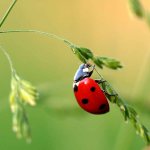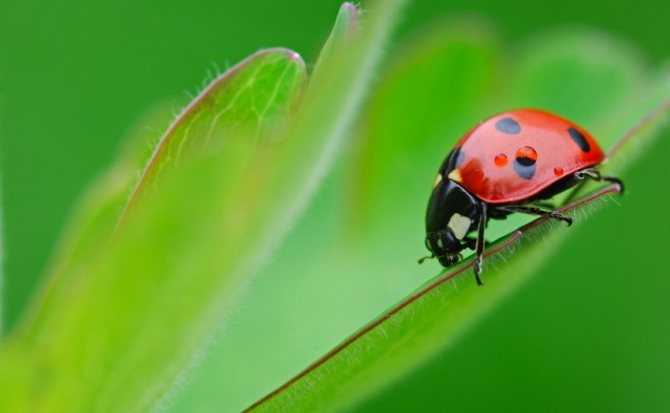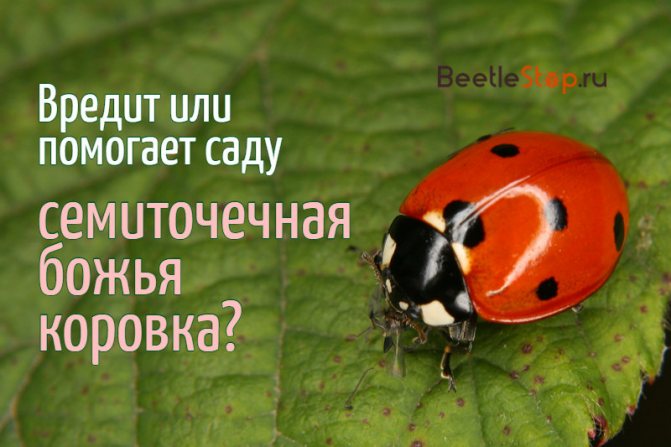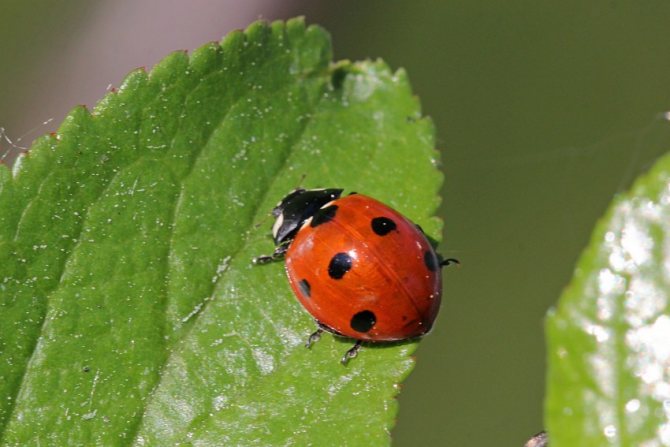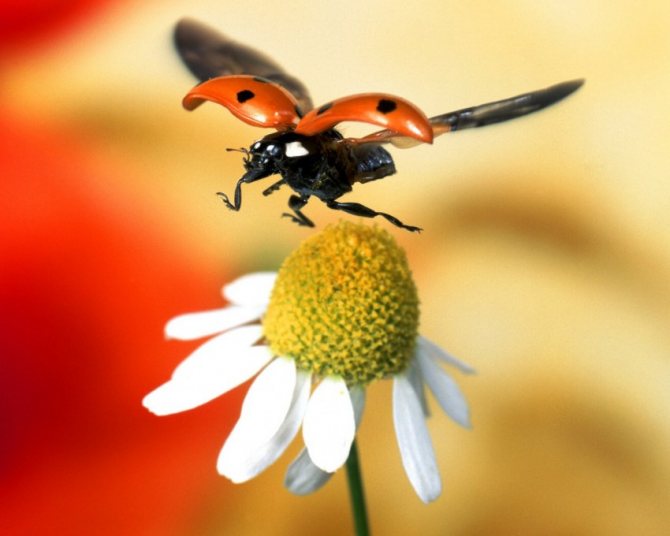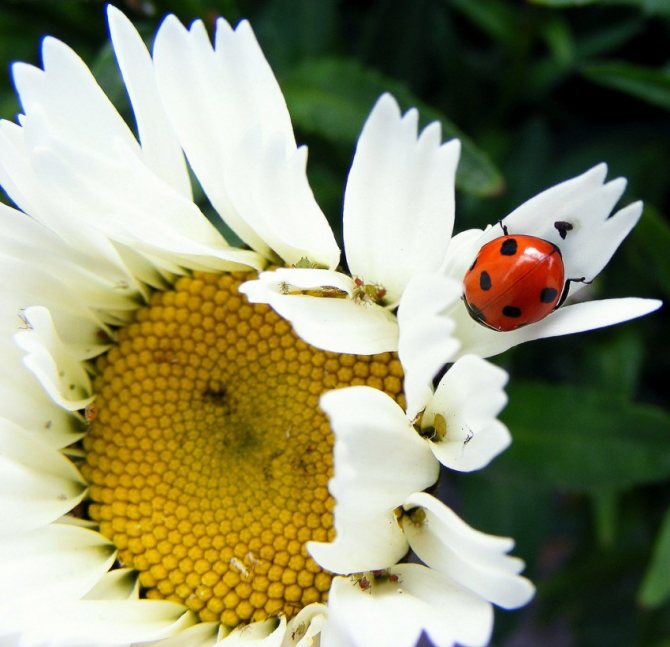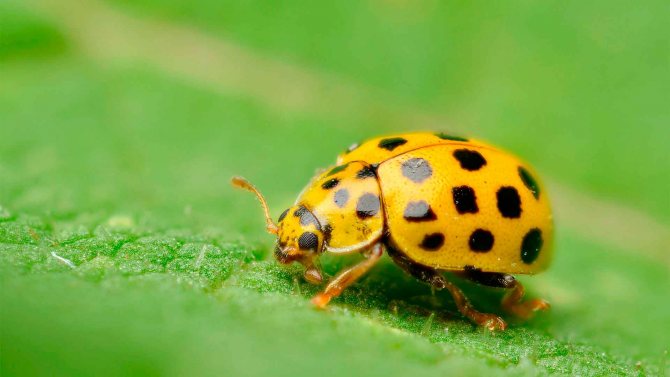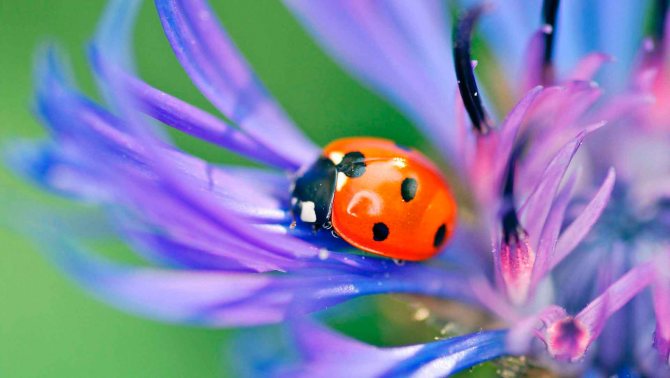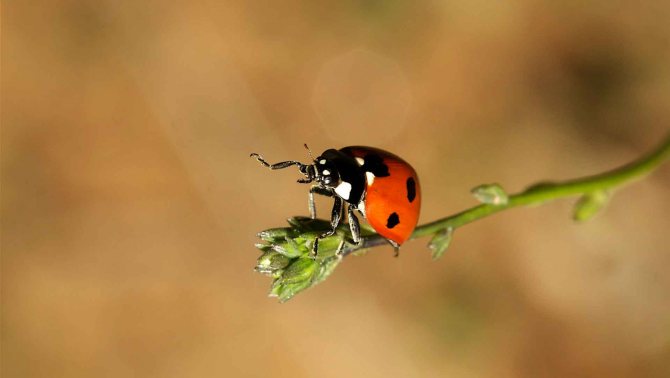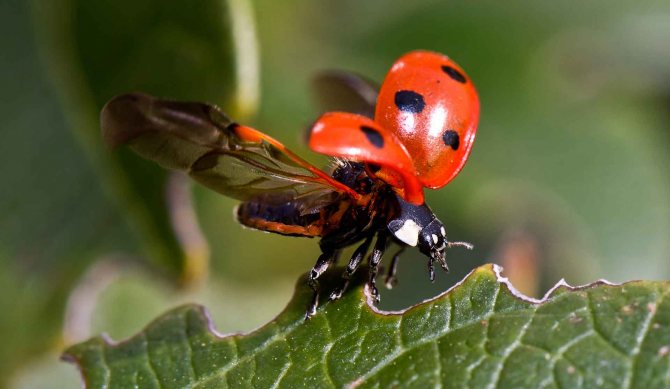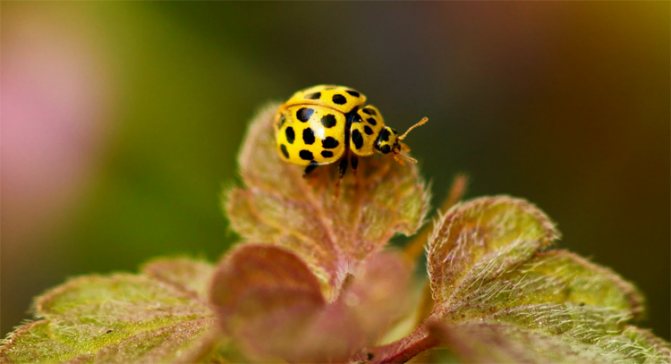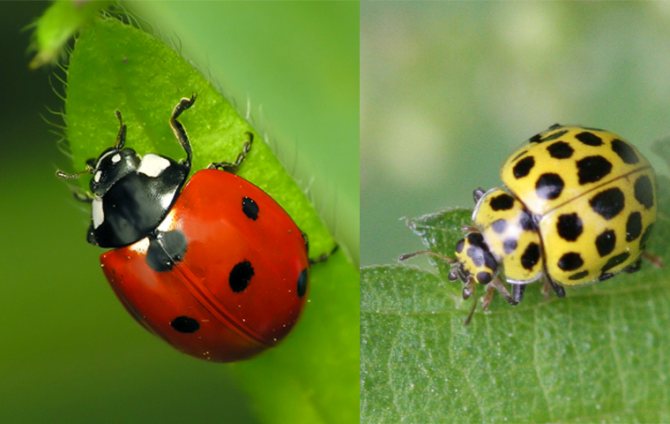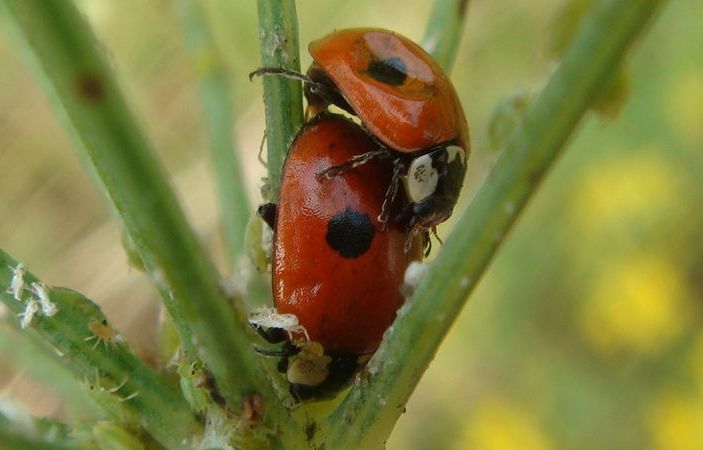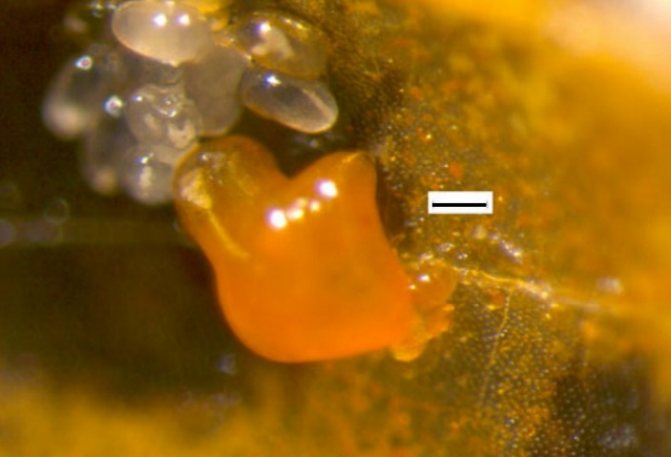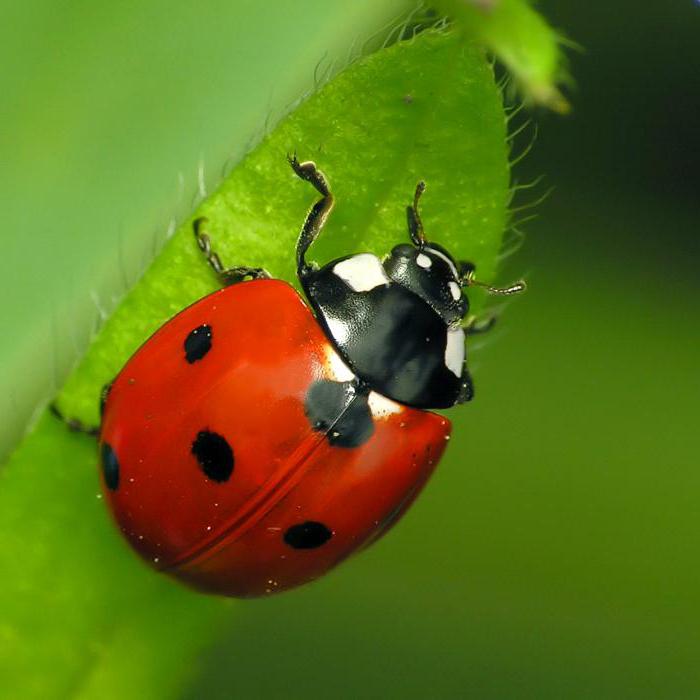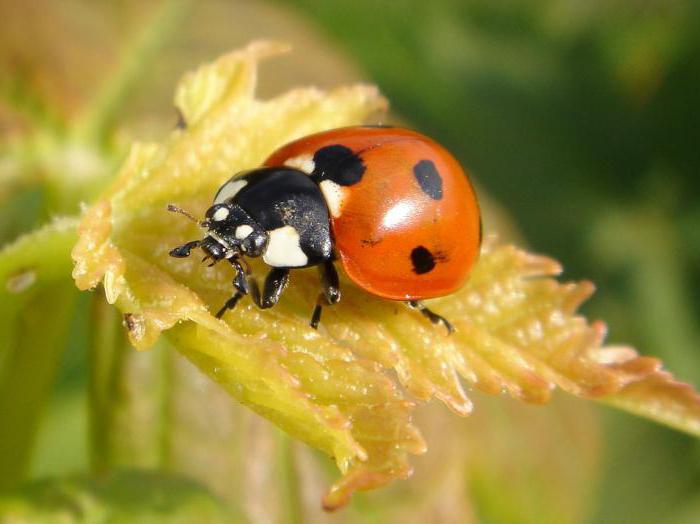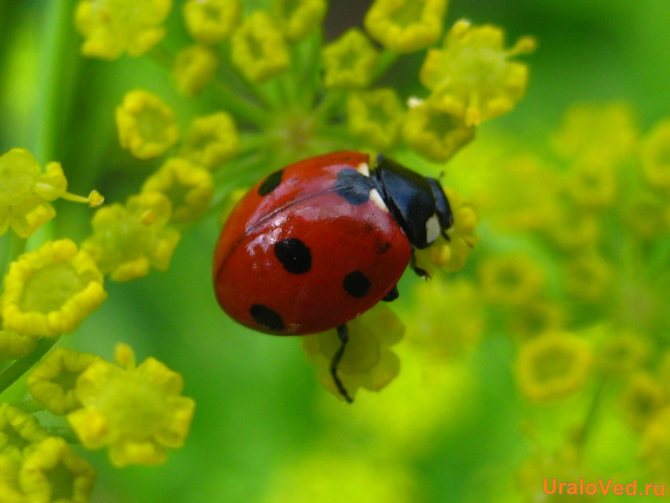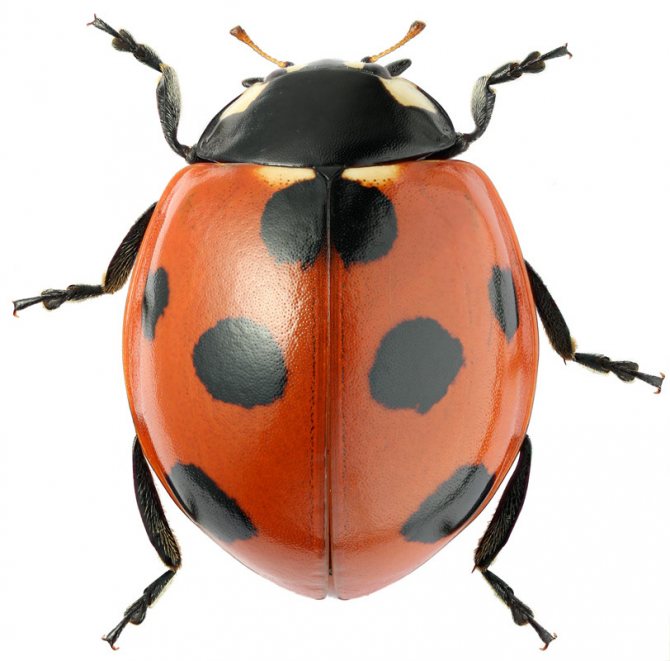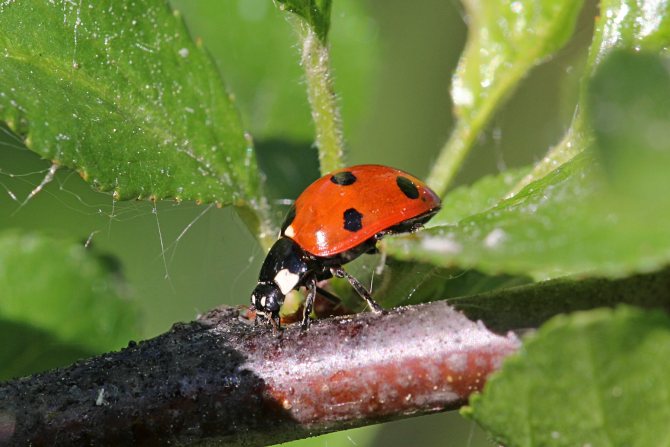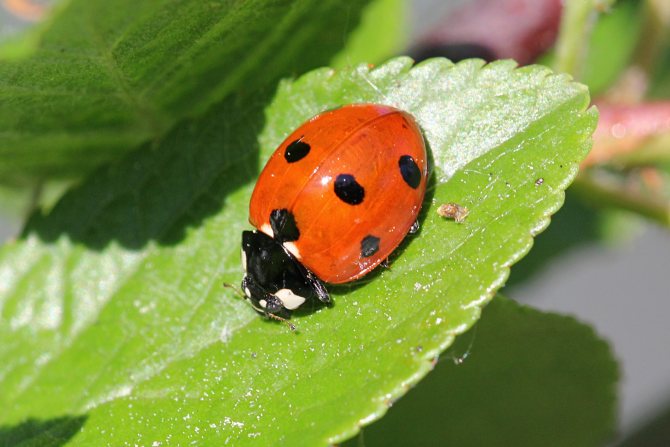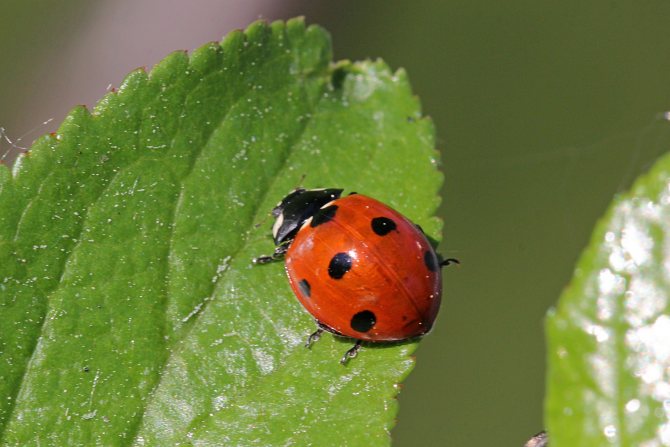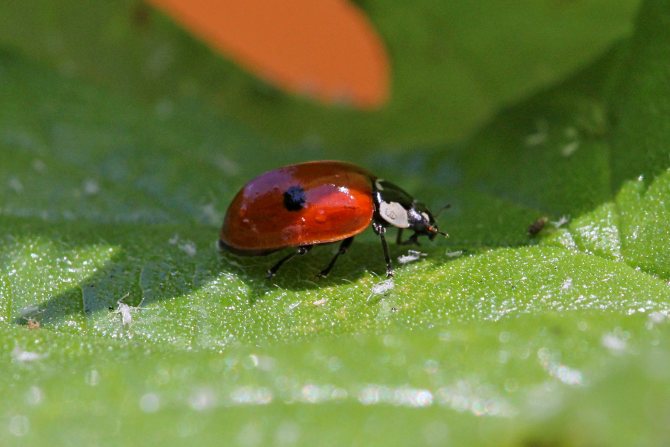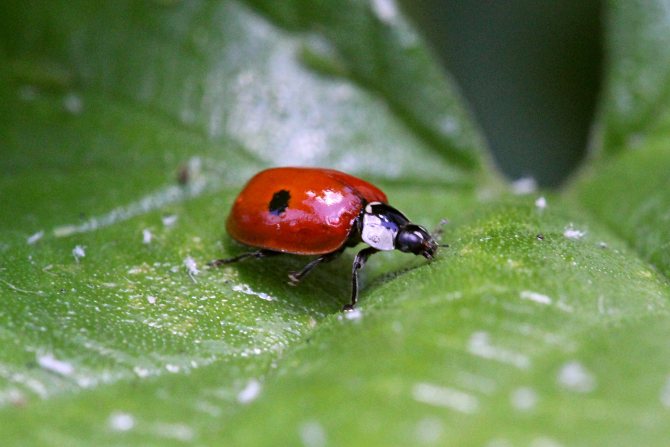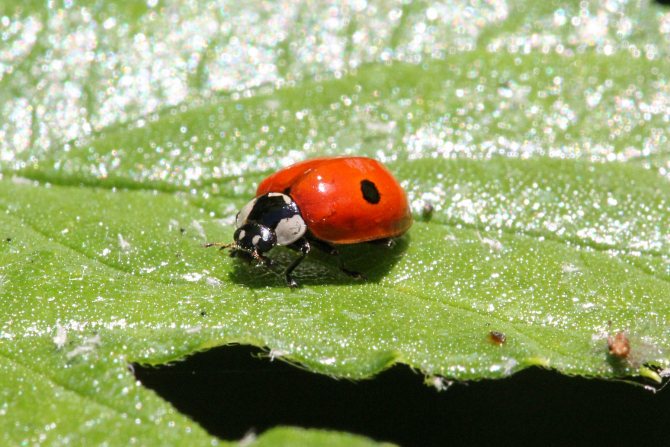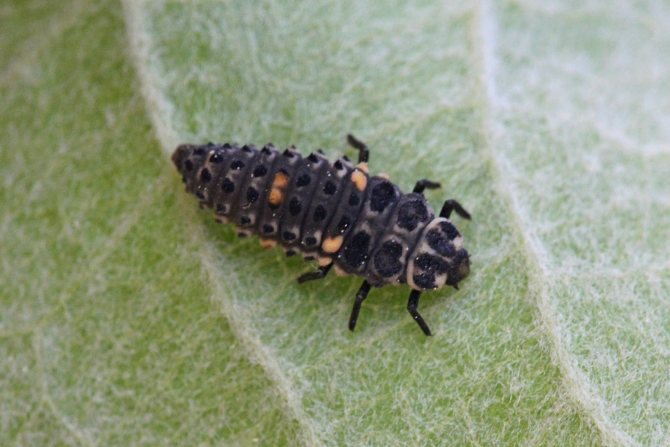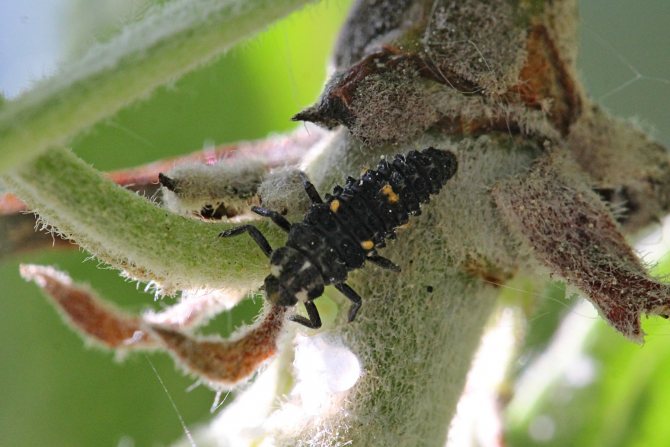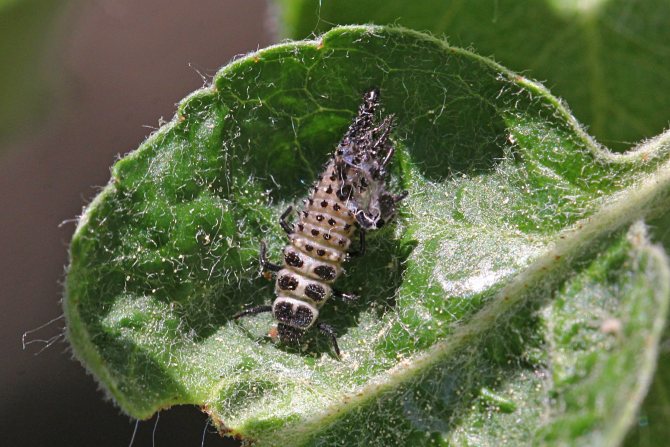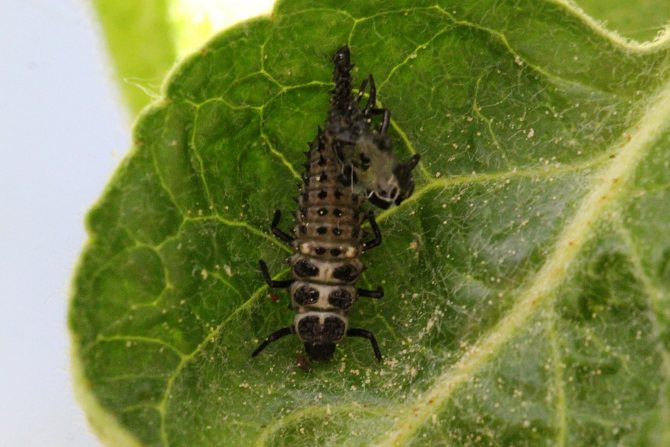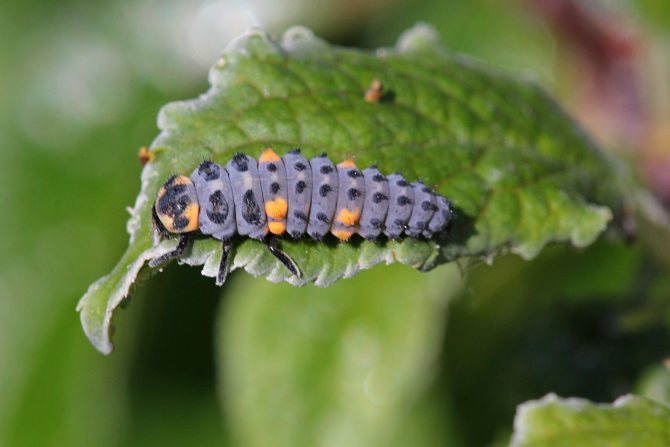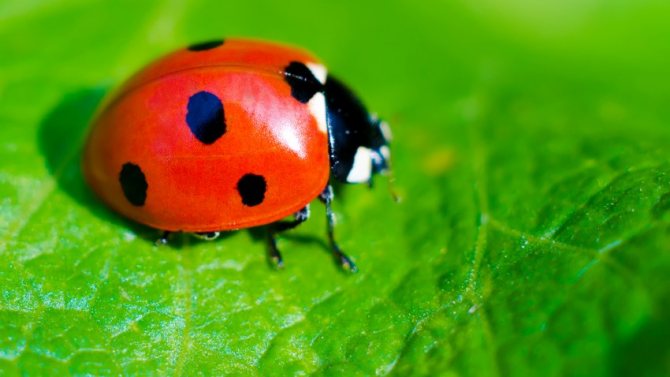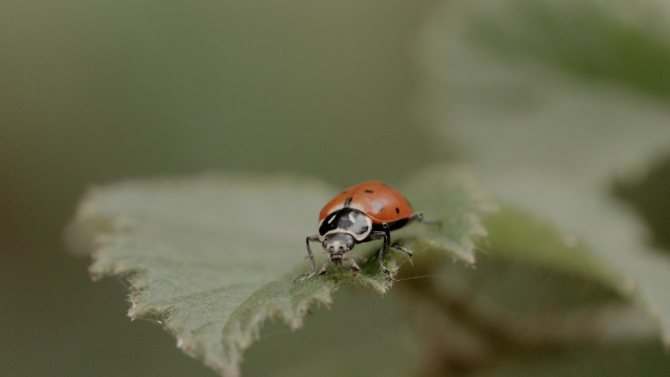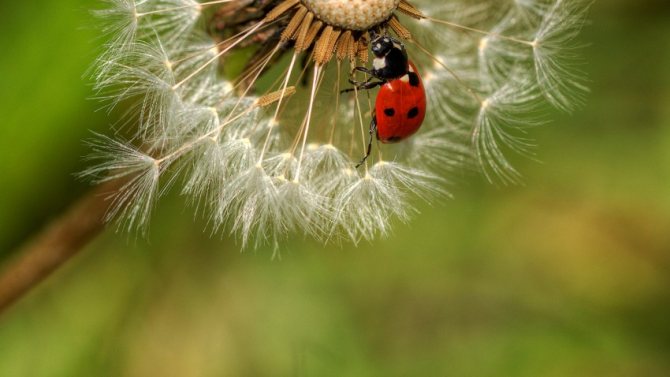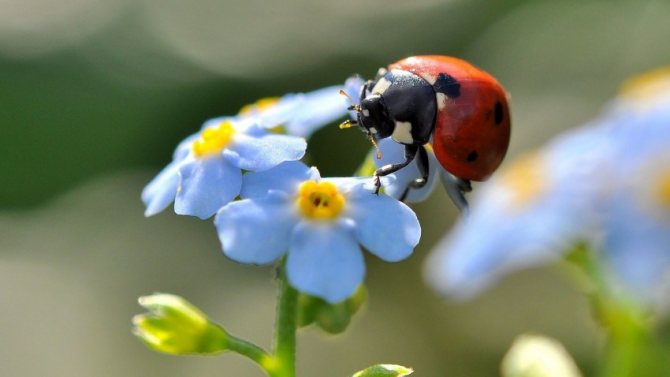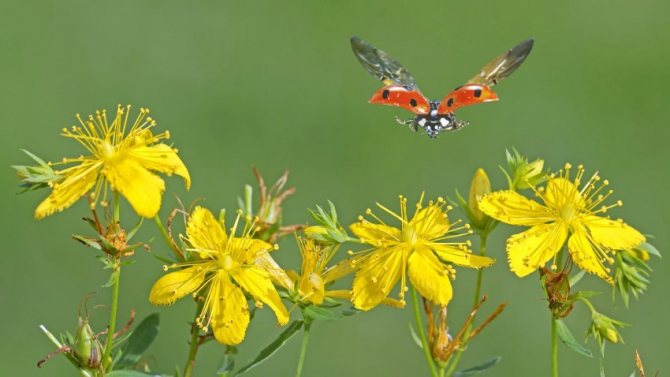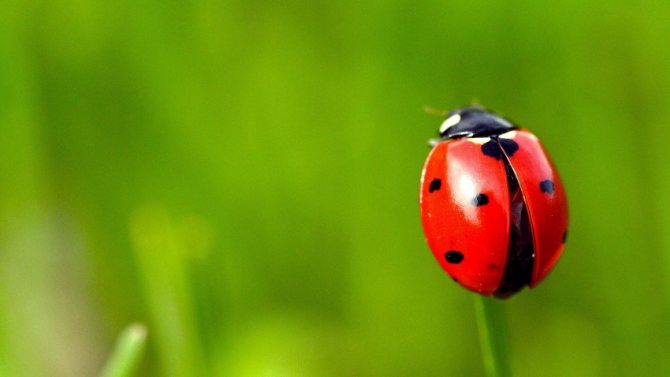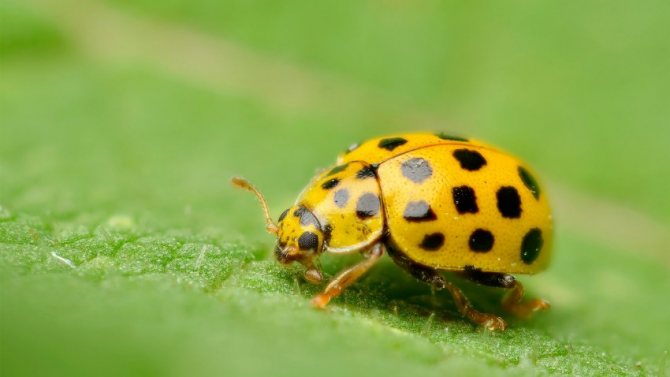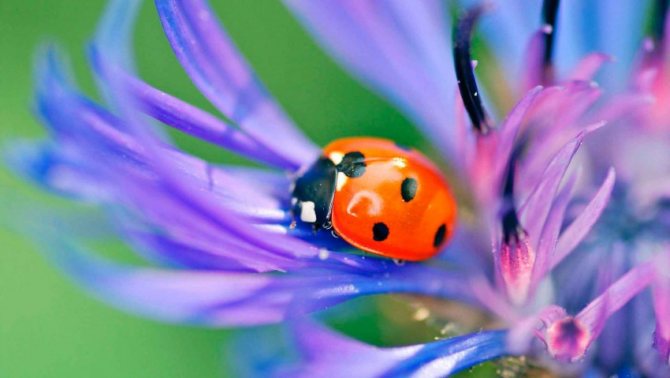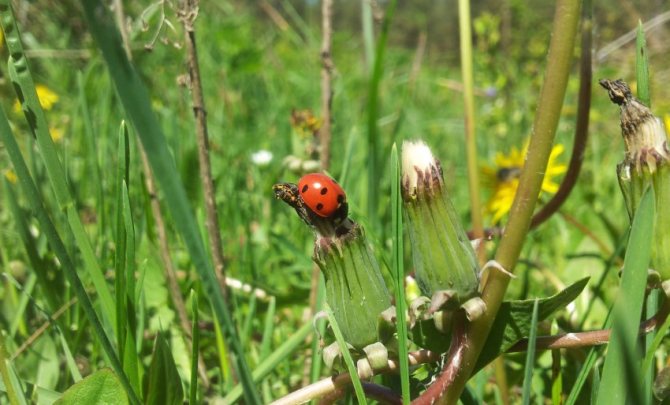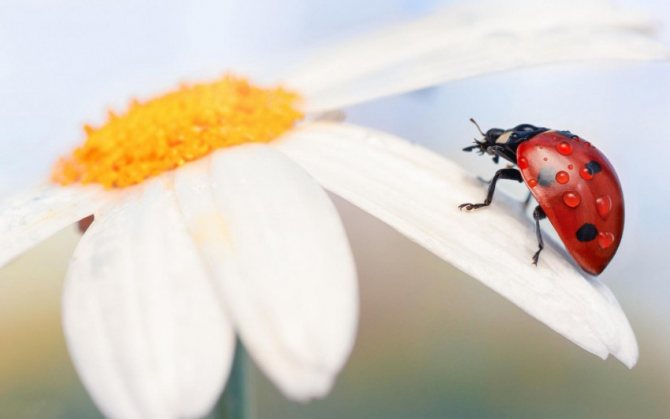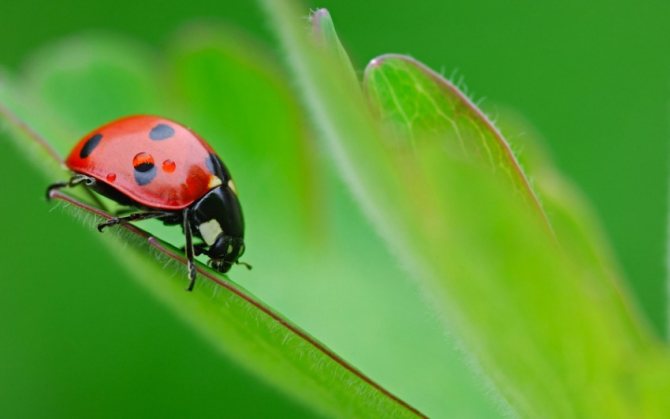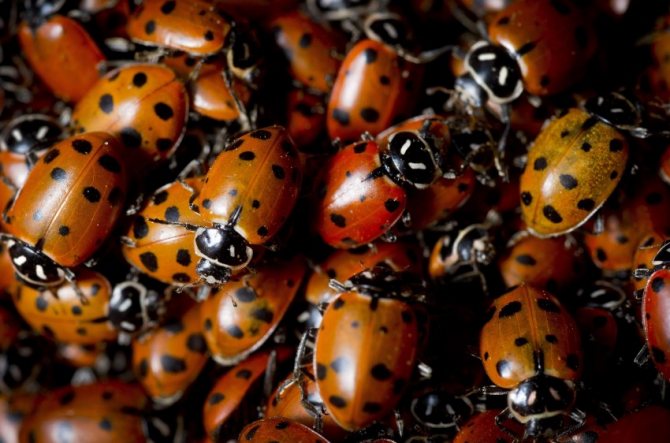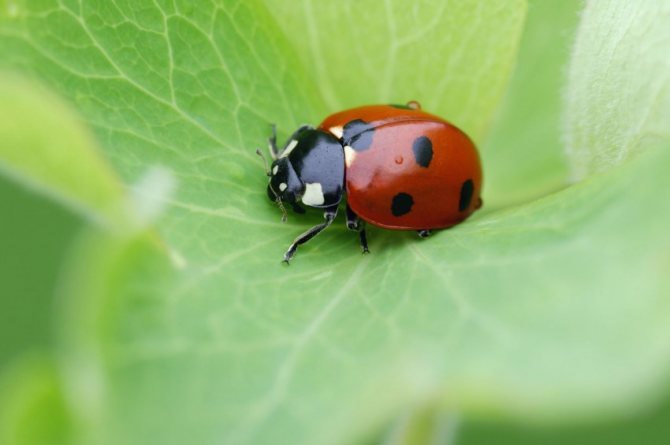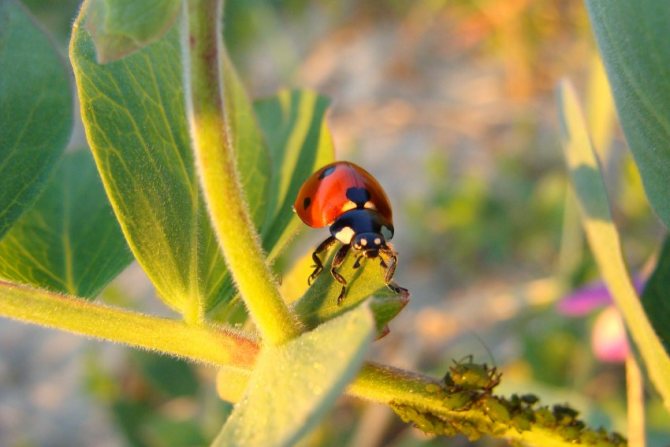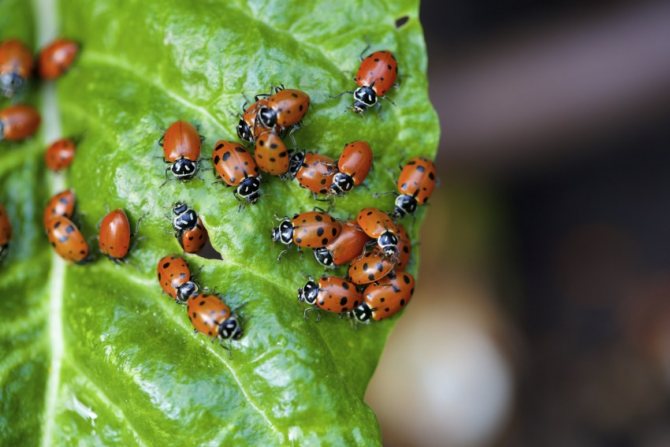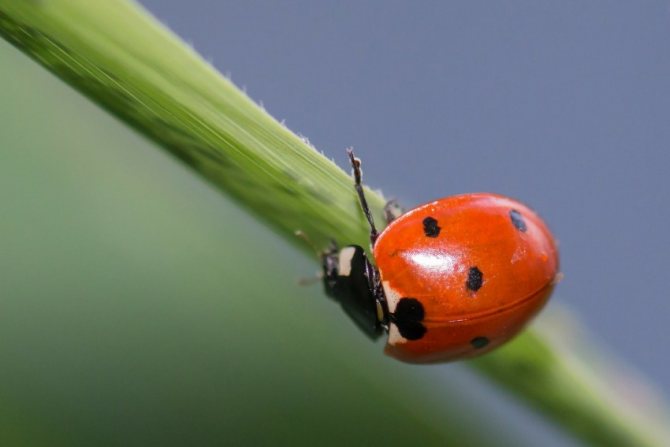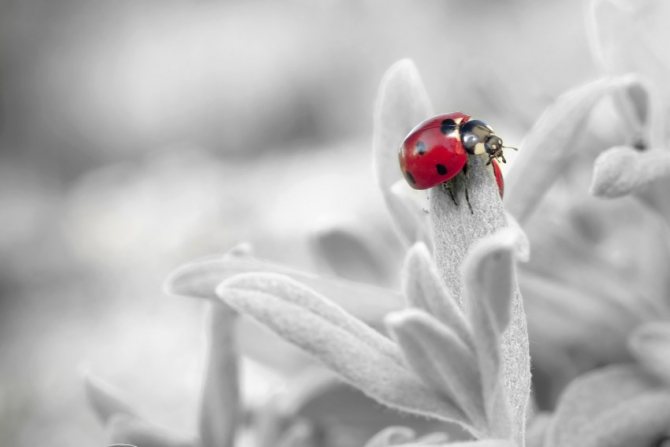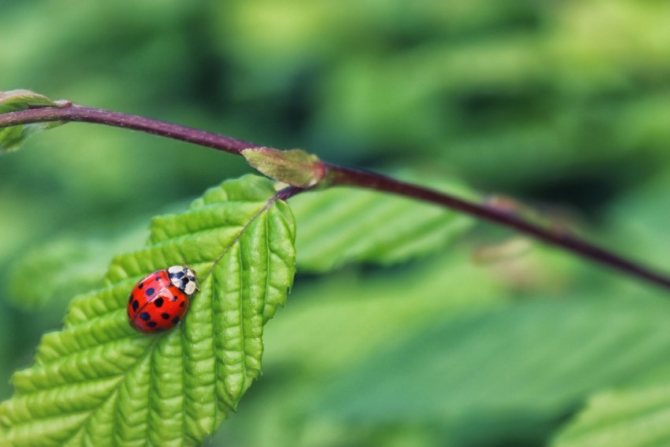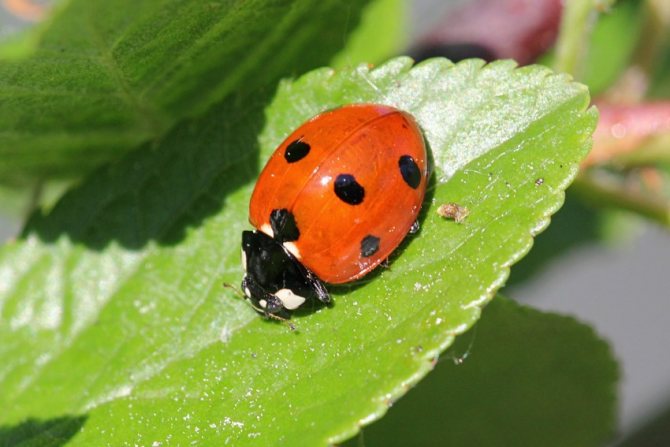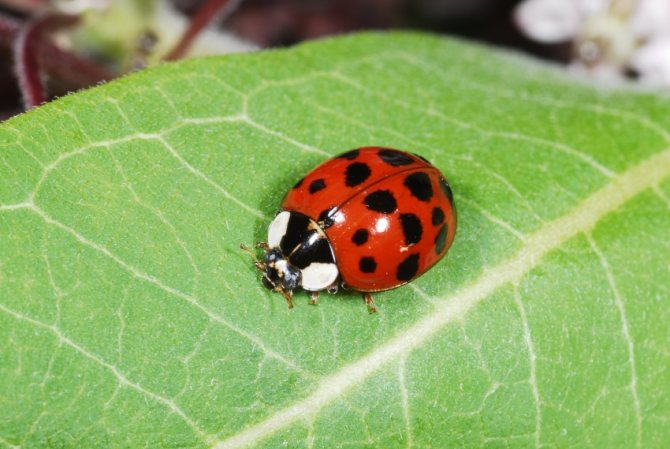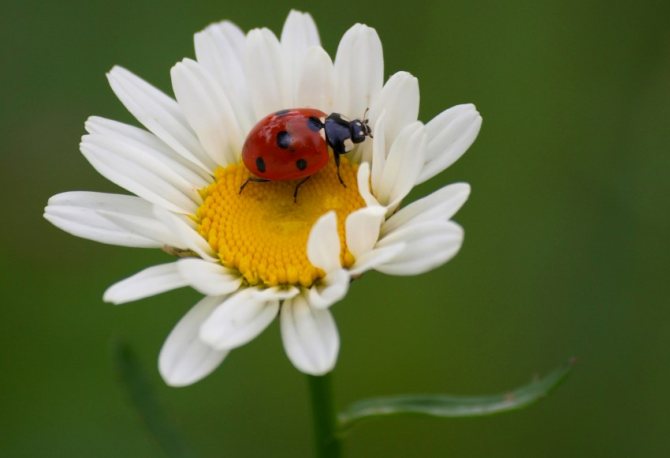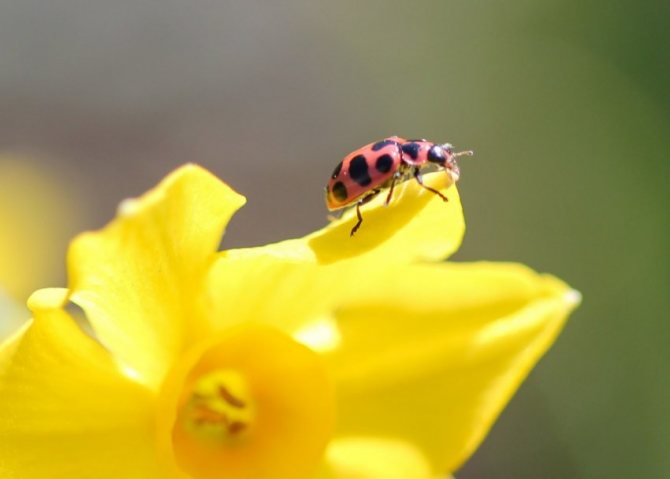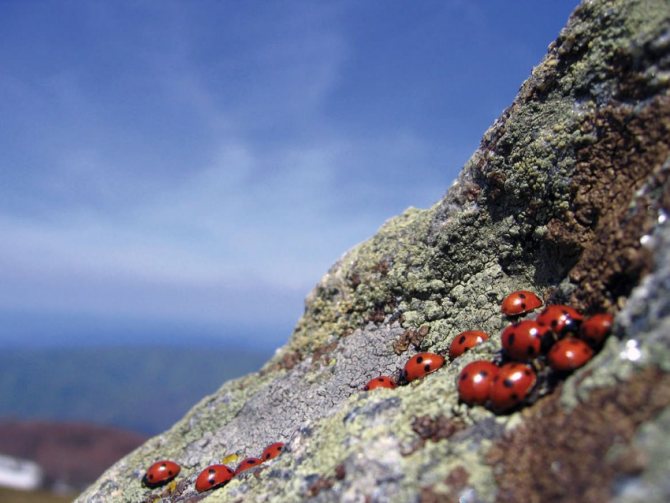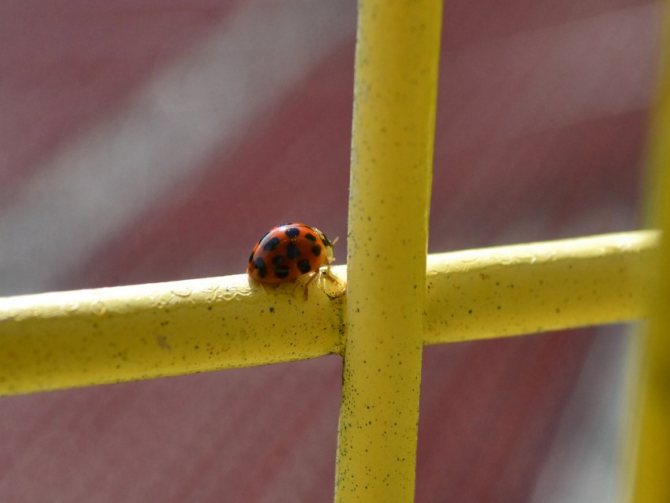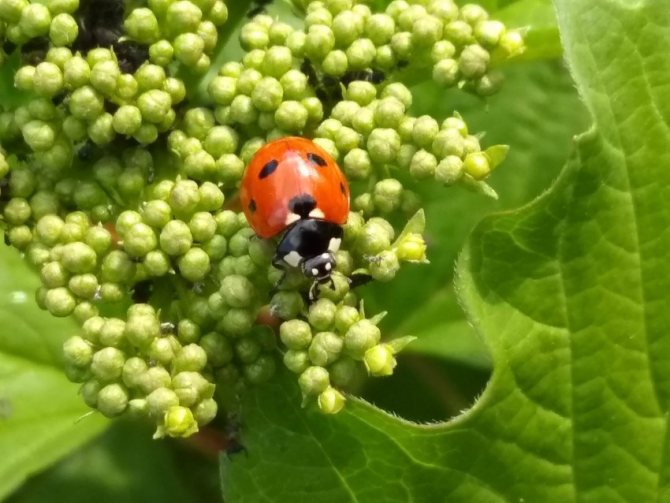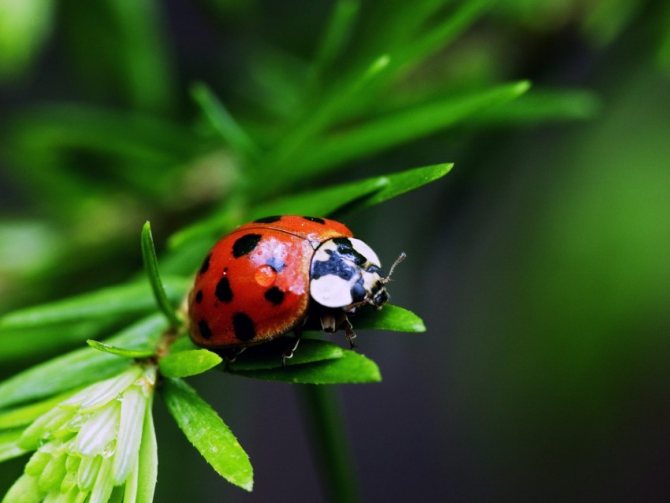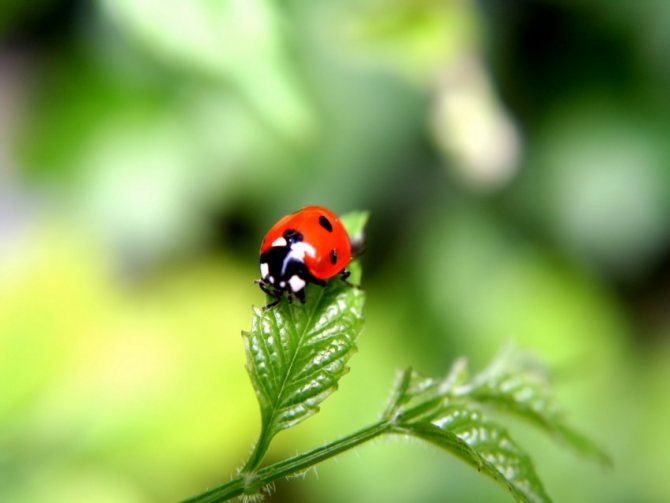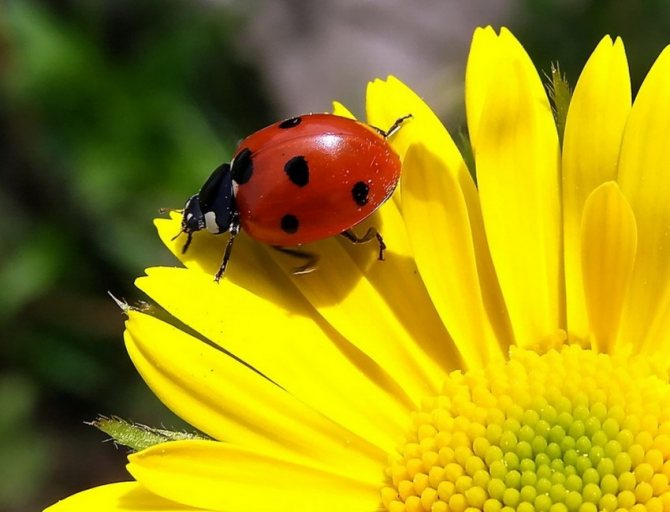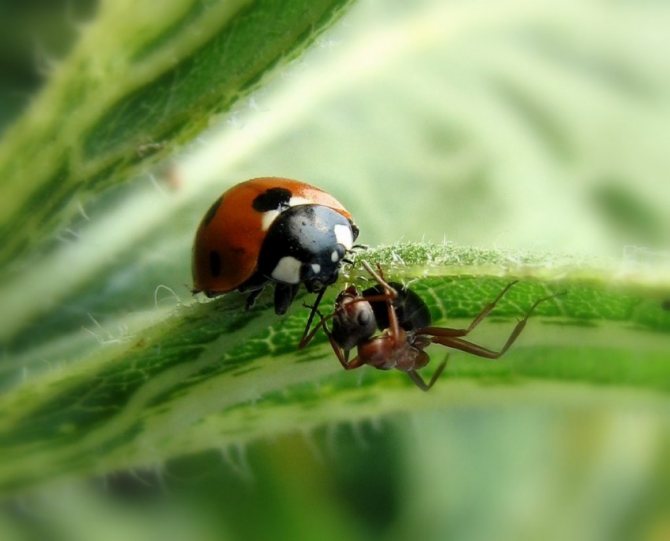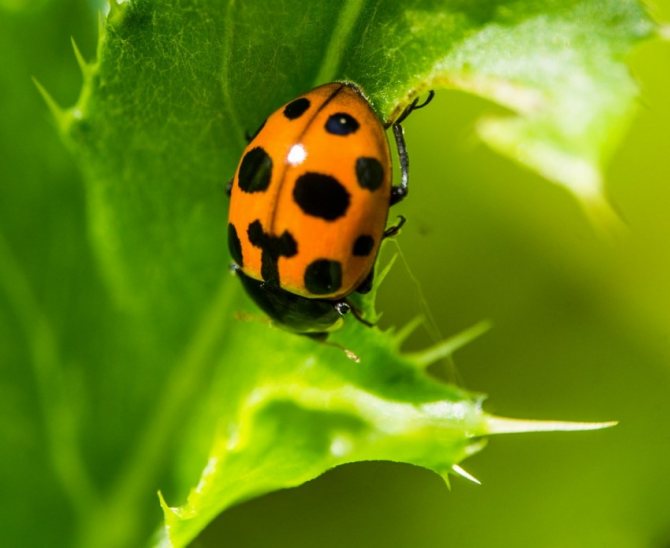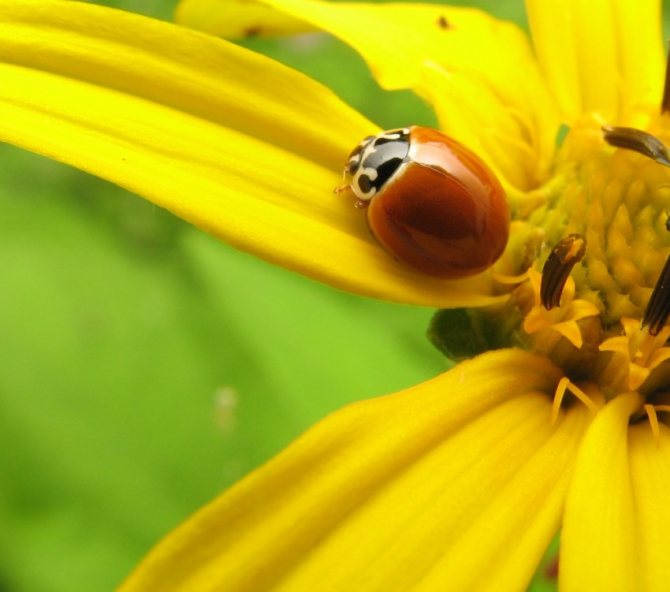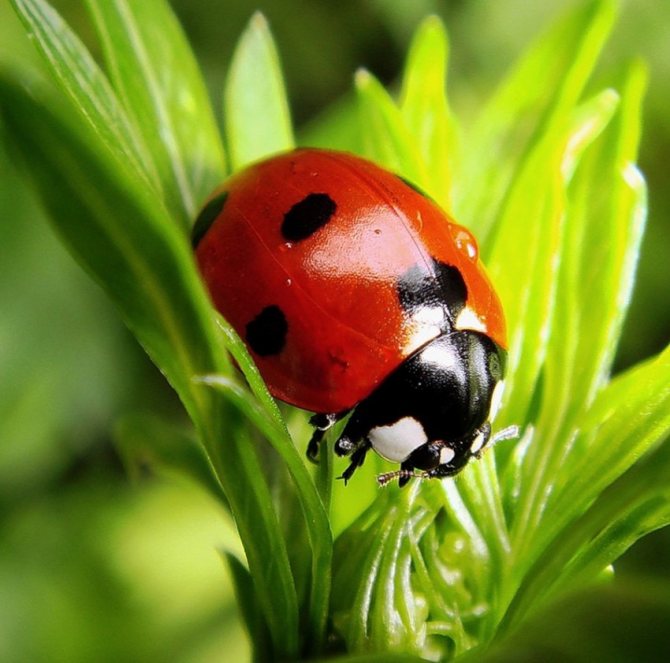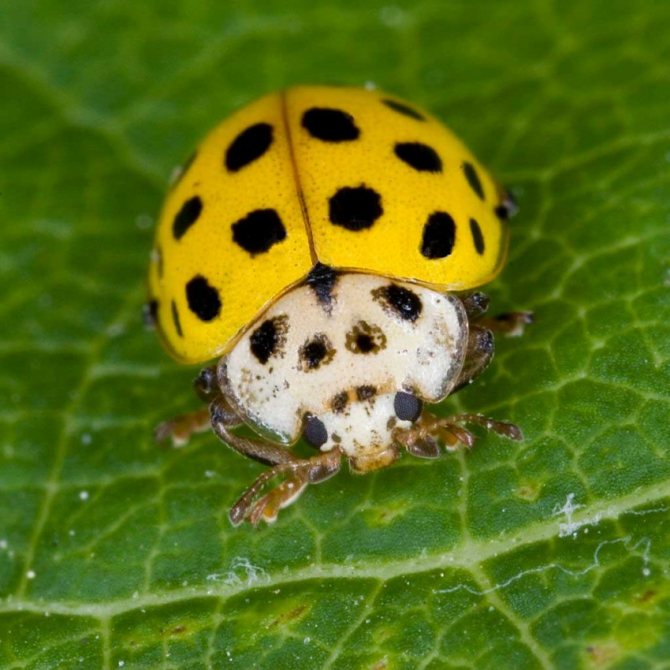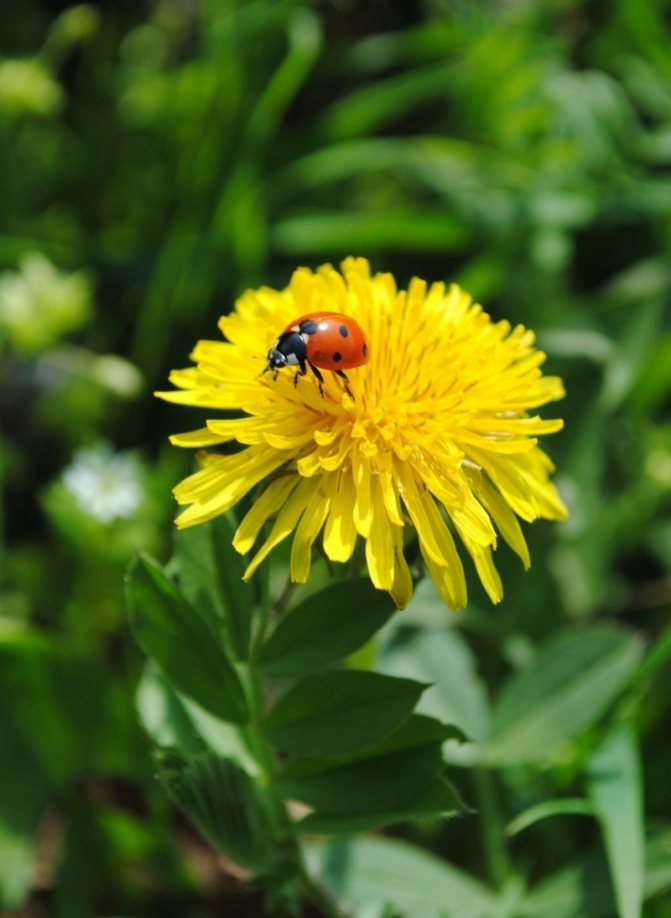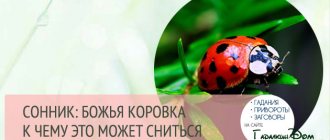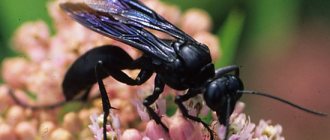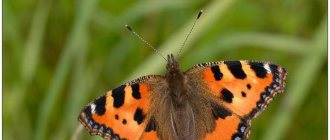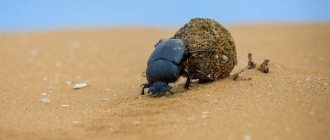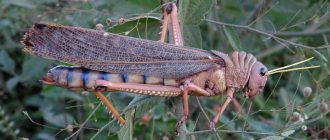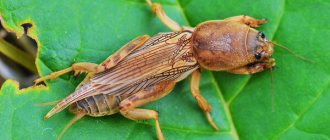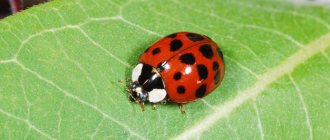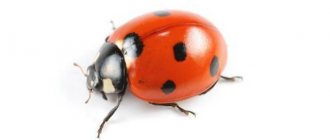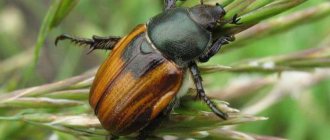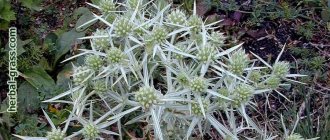30 August24720InsectsLadybugBugs
Everyone knows such an insect as a ladybug. Each of us held this beetle in the palm of our hand and with curiosity counted the number of points on its back. Remember how in childhood we thought how many dots - so many years and the ladybug, how we sang rhymes, begging to fly to heaven ... The ladybug insect evokes joyful and enthusiastic memories from childhood. Below you will find a photo and description of a ladybug, you can learn a lot of new and unusual things about her.
Protection from other animals
Young red ladybirds have a noticeable coloration that scares away predators. Gradually it fades. The warning coloration of beetles is a classic example of mimicry in the animal kingdom. The rich yellow, red, blue, brown colors of various insect species signal danger to predators.
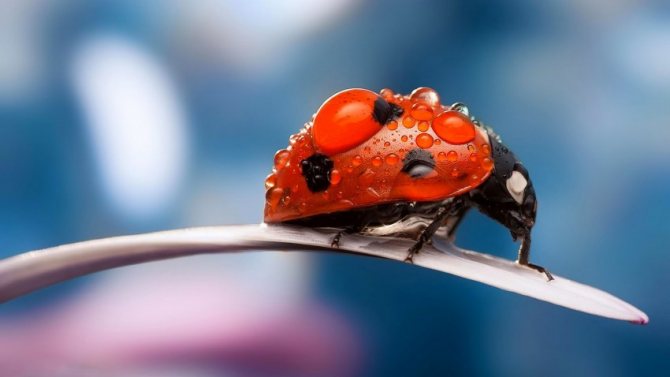
At the time of the attack of birds and other animals, insects secrete a yellow poisonous liquid (it has a very pungent odor). Thus, beetles scare off their enemies: spiders and frogs that hunt ladybirds.
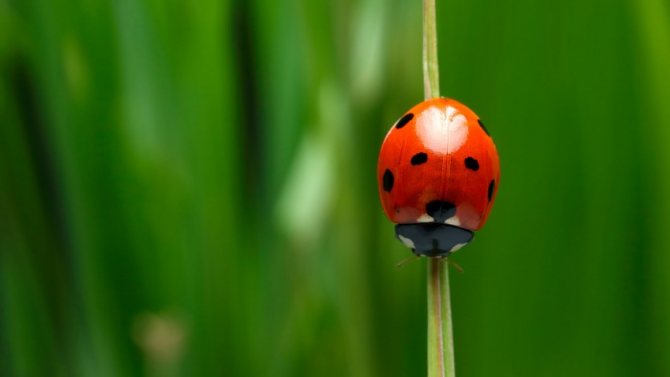

Lifestyle
Representatives of yellow and red ladybirds have the same size up to 12 mm... Any insect of this species has hard elytra. Their main function is to protect the second wing pore during flight. Both red and yellow ladybugs are wonderful flyers. Their wings perform up to 85 strokes per second. Also, in the course of evolution, these little bugs have learned a trick. In case of danger, they pretend to be dead by pressing their paws. Yellow ladybugs live for over a year. Nature has measured the same amount of time for her red sister.
Habitats of ladybugs
Insects lead a solitary life, with the exception of the mating and wintering period. They are found in large numbers on forest edges, they feel comfortable in meadow communities and in the garden.
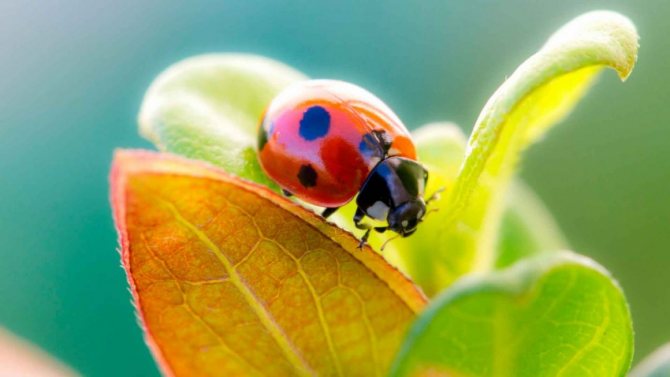

Beetles can live in trees where there are a lot of aphids. Some species live in reeds, as they have legs that are longer than their relatives. They help insects move quickly through aquatic plants.
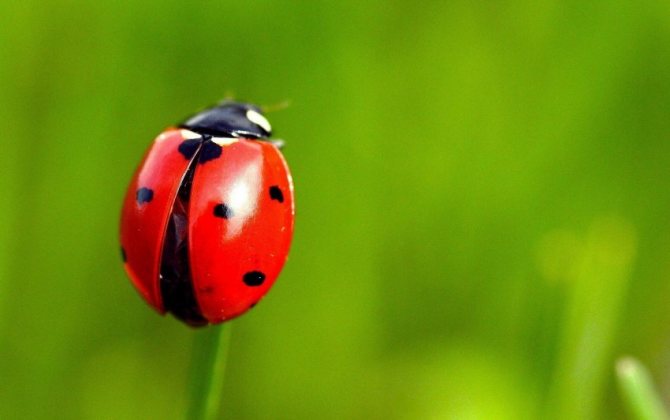

Ladybugs in most cases benefit people by exterminating aphids. There are known cases of deliberate breeding of these insects and moving them with the help of aircraft to areas to combat field pests.
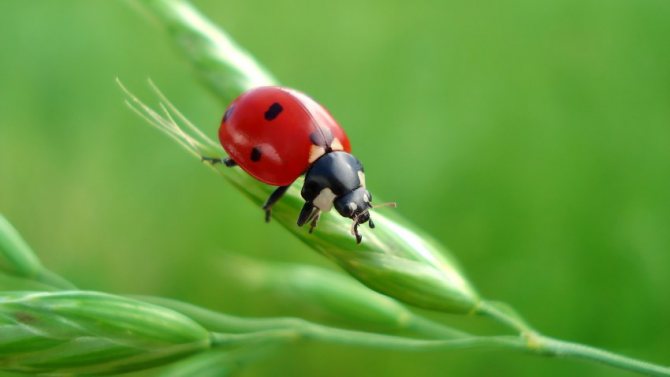

Lifestyle and reproduction
Insects live apart. They are collected in groups only during the breeding and wintering periods. The mating period of ladybirds is in late spring and early summer. It is important for the female to have an adequate supply of nutrients necessary for the formation of offspring. If she is not fed enough, then she avoids mating. The male is looking for a partner for the released pheromones.
The fertilized female makes clutches on the lower part of the leaves. The location is chosen near the aphid colony. The eggs are orange, elongated. Each clutch contains up to 50 pieces. The eggs are rather large, 1.2 mm long, and are fixed in an upright position. In total, the female lays 250-1000 eggs during her life.
The development time of the embryo depends on the temperature - at 15 ° it is 4 days, at 30 ° - 2 days. The size of the larva at birth is only 1 mm. Its first food is the shell of eggs and dead embryos. Young larvae suck liquid from aphids. As they grow older, they eat prey whole. After a month of active nutrition, it grows to a length of 8-10 mm.
The elongated segmented body is dark gray. The head is yellow; there are yellow spots on the sides of the thoracic region and abdomen. The body of the larva is covered with outgrowths ending in black hairs. Movable limbs provide mobility. The voracious larva actively hunts for aphids and eats its eggs. The developmental period includes the change of four ages and three molts. Then comes the pupal stage.
Interesting fact. In 1976, there was an outbreak of mass breeding of ladybirds in England. The insects did not have enough food, they attacked everything. Cases of human bites have been recorded, but they do not pose a danger.
Before pupation, the fourth instar larva is starving for 24 hours. With the tip of the abdomen, it attaches to the plant and pupates. The pupa is orange with black spots. The stage takes 8-12 days, with high temperatures it passes faster. The pupal membrane is torn along the back. A young seven-spotted ladybug appears with soft elytral covers. Her body is unpainted. Complete pigmentation takes about a week.
Photo of ladybug
Can this insect bite or not?
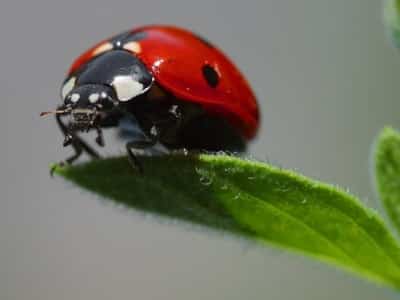

Of the large number of species of ladybirds, and there are more than 5,200 species, only a couple of species bite and are dangerous to humans, for example, Harlequin and with 28 spots. They can bite hard and harm the body. The rest of the species only pinch the prey with their pincers, in the event of an attack or defense.
In a ladybug, a special yellow secretion is secreted from the joints of the legs, which is poison for most insects. It is sharp in smell, bitter in taste, and is able to scare away the main enemies:
- frog;
- insects that feed on cows;
- spiders.
Birds also try to avoid it because of the unpleasant taste.
Important! The ladybug belongs to the class of predators, since it feeds not only on grassy food, leaves, but also on other insects such as slugs, snails, aphids, spider mites, and their relatives.
The onset of the winter period forces the insect to prepare for hibernation. The cow stores nutrients, removes excess water from her body. At this time, from the end of September, she becomes as aggressive as possible and can even attack a person.
An excerpt characterizing the Two-point ladybug
- But if he is an ignoble person? "He! ... an ignoble man?" If you only knew! - Natasha said. - If he is a noble person, then he must either declare his intention, or stop seeing you; and if you don’t want to do it, then I’ll do it, I’ll write to him, I’ll tell Daddy, ”Sonya said resolutely. - Yes, I can not live without him! Cried Natasha. - Natasha, I don't understand you. And what are you saying! Remember your father, about Nicolas. - I do not need anyone, I do not love anyone but him. How dare you say that he is ignoble? Don't you know that I love him? Shouted Natasha. “Sonia, go away, I don’t want to quarrel with you, go away, for God's sake, go away: you see how I suffer,” Natasha shouted angrily in a restrained irritated and desperate voice. Sonya burst into tears and ran out of the room. Natasha went to the table and, without thinking for a minute, wrote the answer to Princess Marya, which she could not write the whole morning. In this letter, she briefly wrote to Princess Marya that all their misunderstandings were over, that, taking advantage of the generosity of Prince Andrey, who gave her freedom when leaving, she asks her to forget everything and forgive her if she is guilty before her, but that she cannot be his wife ... All this seemed to her so easy, simple and clear at that moment. On Friday, the Rostovs were supposed to go to the village, and on Wednesday the count went with the buyer to his Moscow region. On the day the count left, Sonya and Natasha were invited to a big dinner at the Karagin's, and Marya Dmitrievna took them.At this dinner Natasha again met with Anatole, and Sonya noticed that Natasha was saying something to him, wishing not to be heard, and during the dinner she was even more agitated than before. When they returned home, Natasha began the first with Sonya the explanation that her friend had been waiting for. - Here you, Sonya, said various nonsense about him, - Natasha began in a meek voice, the voice that children speak when they want to be praised. - We have explained to him today. - Well, what, what? Well, what did he say? Natasha, how glad I am that you are not angry with me. Tell me everything, the whole truth. What did he say? Natasha pondered. - Oh Sonya, if you knew him as I do! He said ... He asked me how I promised Bolkonsky. He was glad that it was up to me to refuse him. Sonya sighed sadly. “But you didn't refuse Bolkonsky,” she said. - Or maybe I refused! Maybe it's all over with Bolkonsky. Why do you think so badly of me? - I don't think anything, I just don't understand it ... - Wait, Sonya, you will understand everything. You will see what kind of person he is. Don't think bad about me or about him.
What does this insect eat and what benefits does it bring to humans?
The seven-spot ladybug is a predator. Moreover, at any stage of its development, it feeds exclusively on other bugs. It mainly eats various types of aphids, which live on all kinds of plants and trees. In addition, the bug eats the eggs of other insects: butterflies, moths, etc.
Such a beetle can be most often observed on fruit trees, currant bushes, as well as on pine, aspen and bird cherry. The presence of such plants in the regions of our country indicates a large number of these insects.
Many farmers use ladybirds as a healer and aphid reliever to preserve their crops. On a hot day, the number of these red bugs increases, especially near water bodies, roads and stones heated by the sun.
Appearance
Larva
During the maturation stage, the round, cylindrical larvae pass through four instars, changing in color from a uniform rich gray to black with well-defined patches of yellow and orange.
Adult
Growing up, the beetle reaches a size of five and a half centimeters. Possessing a highly volatile
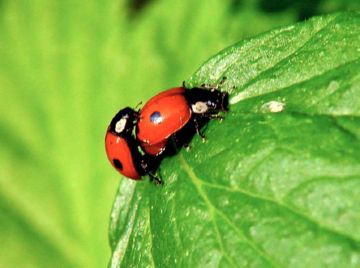

coloration, ladybugs can be black with red spots, although red or orange elytra, decorated with two symmetrical black spots, are more common.
The legs and breast of the beetle are glossy black, and the mandibles and antennae are of a lighter brown color. Also, depending on the general color, the color of the pronotum also changes - in light beetles it is yellow with one black spot, and in dark beetles it is black with a yellow edging.
Cow twenty-two-point, or psillobora (lat.Psyllobora vigintiduopunctata)
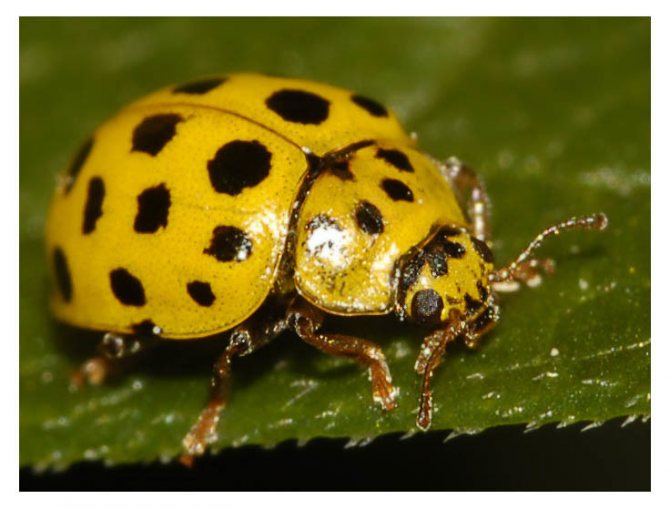

0
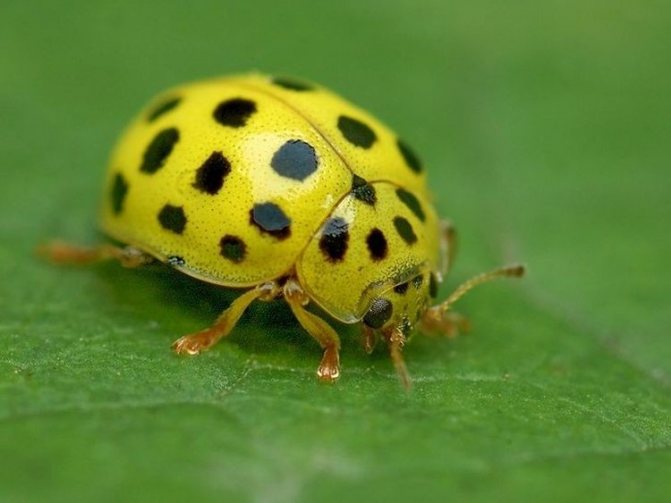

0
A twenty-two-point cow, or psillobora (lat.Psyllobora vigintiduopunctata). Beetle up to 3-4.5 mm long, black below, lemon-yellow above. The body is hemispherical. The head of the male has two black dots, the head of the female is black. Pronotum with five black spots. Each elytron has eleven black spots: four along the suture, three along the middle, three along the edge and one at the edge. Sometimes the spots disappear or merge into a sling.
Favorite food of insects
The two-spotted ladybird is the most active predator, destroying aphids both in the form of an adult beetle and in the form of a larva. Each adult beetle eats up to 1500 individuals in a lifetime., which allows us to conclude that ladybirds are extremely useful. The total mass of two-spotted ladybirds feeds on various species of aphids, but there are also those who prefer only one favorite species and are ready to make long flights in search of it.
In addition to aphids, ladybugs do not disdain scale insects, mealybugs, ticks, whiteflies, and a small part generally prefers spores of fungi and plant pollen.
The species of ants in Russia are very diverse - here you can find both large insects living in the forest and small domestic ants. The blue fly has a shiny black breast with a blue tint. Read the full description of this family here.
There are many species of wasp insects that lay eggs in the body of the host insect. Read more about this family of parasitic insects here.

